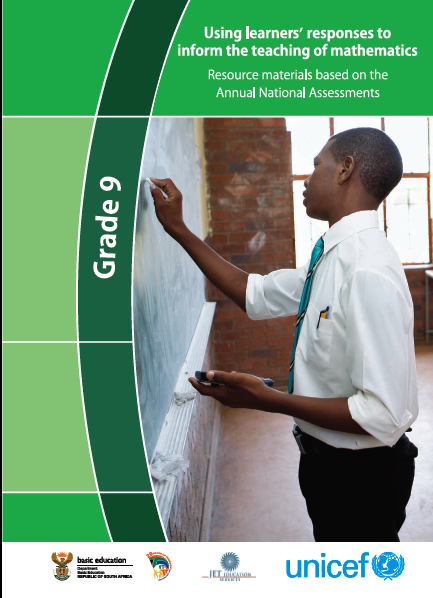Using learners' responses to inform the teaching of mathematics: Resource materials based on the annual national assessments.
These materials are the output of the Annual National Assessment (ANA) data-usage project, a combined UNICEF, Department of Education (DBE) and JET Education Services (JET) initiative. The goal of the project was: Improved quality of teaching and learning through effective usage of ANA data and reports.

The Annual National Assessments (ANA) were standardised national assessments which were intended to measure learners’ progress in language and mathematics in the senior phase (grades 7 - 9) and intermediate phase (grades 4 – 6) and in literacy and numeracy in the foundation phase (grades 1 – 3). The ANAs were piloted in 2009 and conducted annually from 2011 to 2015, beginning with grades 1 to 6 in 2011 and adding grade 9 in 2012. The DBE supplied the question papers and marking memoranda and the tests were administered, marked and moderated by the schools.
After each administration of the ANA, the DBE released a diagnostic report, the purpose of which was to “highlight and present to teachers…specific areas of Language and Mathematics knowledge and skills in which learners…were found to be inadequately equipped” (DBE, 2012. Diagnostic report; Annual National Assessment, 2012). In the 2013 Diagnostic Report, diagnostic analysis is described as the investigation of “common errors” and of learners’ “misconceptions”. This is akin to error analysis, which is the study of the errors in learners’ work with a view to looking for the causes and explaining the errors. Proper error analysis is a multifaceted activity – it involves analysis of correct, partially correct and incorrect methods of solution. Importantly, it also implies the study of best practices for remediation. This requires that teachers have (a) good mathematical content knowledge; (b) a good grasp of learners’ levels of mathematical understanding; and (c) an understanding of pedagogical content knowledge in order to be able to anticipate learners’ errors and misconceptions. The use of error analysis can therefore also highlight the gaps in teachers’ knowledge and teachers’ own developmental needs.
In 2013, JET conducted an evaluation of the Primary School Mathematics Improvement Project (PSMIP), a joint project of the Department of Basic Education (DBE) and the Japan International Cooperation Agency (JICA) and used error analyses of learners test scripts in the evaluation to determine the type and frequency of common errors. The error analysis clearly showed how much can be learnt if learners’ scripts are analysed to determine what errors were made.
JET’s use of error analysis in the JICA evaluation opened discussions with the DBE on how error analysis applied to the Annual National Assessments (ANA) could be turned into a teacher development intervention and lead to improvement in learner achievement. The result was the abovementioned ANA data-usage project. The need for teachers to analyse Annual National Assessment (ANA) and other test items productively as well as research which shows that teachers are often not equipped to design and implement teaching interventions based on the errors made by learners provided the basis for the conceptualisation of the project. One of the project’s goals was to develop resource material which details: typical errors learners make; partial understanding learners demonstrate in their working; mathematically sound strategies learners make use of in each question; and possible teaching strategies that could be used to improve learners’ acquisition of a particular skill/concept.
From the Minister’s introduction:
"This set of materials has therefore been developed to build the capacity of teachers to analyse the ANA and other test in order to identify typical errors made by learners and thereafter select appropriate teaching strategies to correct these errors and improve the teaching of Mathematics".
For more on error analysis, see Herholdt, R. and Sapire, I. (2014). An error analysis in the early grades mathematics-A learning opportunity? South African Journal of Childhood Education, 4(1), pp.43-60.
